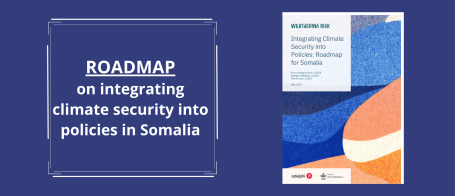Integrating Climate Security into Policies: Roadmap for Somalia
Download the full roadmap here.
As climate change increases temperatures and intensifies extreme weather events, Somalia faces severe threats to water, food, and livelihood security. Climate hazards include rising temperatures, variable precipitation, floods, and droughts, aggravate existing vulnerabilities, particularly for those dependent on climate-sensitive livelihoods like pastoralism and agriculture. Decades of conflict and instability have further weakened the state's capacity to respond to these threats, risking increased conflict and unrest. It is crucial for authorities to design policies that recognize the interconnections between climate change, peace, and security dynamics to effectively manage and mitigate these challenges. Key vulnerabilities identified include:
- Heat stress and shifting rainfall patterns threaten to further shift traditional grazing patterns and exacerbate resource competition between pastoralists and sedentary communities
- Climate-sensitive livelihoods are especially vulnerable to climate change effects, which can indirectly aid non-state armed group (NSAG) recruitment and legitimacy
- Powerful actors can exploit climate impacts to capture vital and scarce resources or capitalise on climate insecurity to further political or personal interests, which can fuel community conflict
- Compounding livelihood, food and water insecurity can increase already unmanaged mobility to urban centres that are already under pressure from climate stresses
To mitigate the risk of climate change exacerbating conflict and instability, climate security must be integrated into sustainable development and post-conflict recovery measures. This requires overcoming institutional barriers such as corruption, informal power networks, and a disconnect between federal and local governance. Addressing these challenges is critical for a climate and conflict-resilient future. The roadmap advocates a structured approach to policy integration, highlighting:
- Immediate steps to raise climate security awareness among stakeholders at all governance levels
- Short-term objective to invest in key capacities at federal, state, district, and local levels, particularly where effective systems exist
- Medium-term plan to develop a national vision for climate change with a clear framework for stakeholder coordination
- Medium-term strategy to establish a dedicated space for climate security coordination and cooperation
- Medium-term priority to enhance regional learning on climate security through bodies like IGAD
- Long-term goal to advocate for integrating climate-related security risks in the UNFCCC reporting system
This roadmap was supported by Weathering Risk and is one of four initiatives derived from research conducted under the year-long project adelphi implemented with CGIAR as part of the 'SDG-Climate Facility: Climate Action for Human Security' in the MENA region.
For a summary of the SDG-Climate Facility: Climate Action for Human Security project and an overview of its methodology, findings and recommendations, read Climate, Peace and Security Programming in the Arab States: Considerations for integrated programming in Jordan, Yemen, Iraq and Somalia.
Share on


